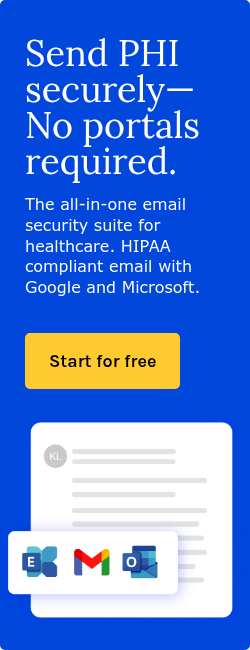5 min read
How EHRs, AI, and secure communication can improve patient care
Caitlin Anthoney April 28, 2025

What are electronic health records?
Electronic health records (EHRs) are digital versions of a patient’s medical history, replacing paper-based files. It includes details, like diagnoses, prescriptions, lab results, allergies, immunizations, and imaging reports.
EHRs and patient care
EHRs give healthcare providers full access to a patient’s entire medical history, medication list, allergy profile, and test results through centralized platforms.
According to a review article on the impact of electronic health records on patient care and outcomes, published in the World Journal of Advanced Research and Reviews (2024), EHRs "have significantly improved patient care by enhancing accessibility and accuracy of patient information."
When a provider can see past diagnoses and prescriptions in seconds, they avoid redundant tests and better tailor treatment plans. According to the same study, EHRs also reduce the chance of errors and streamline documentation. For example, automated coding and billing processes have reduced practices' administrative time.
In a practical sense, this translates into faster visits, fewer mistakes, and clearer communication among physicians, specialists, and pharmacists. In small practices or large hospitals alike, improved workflows mean fewer missed details and better-coordinated treatment plans.
For patients, access to their electronic health records can have several benefits. “The benefits range from re-assurance, reduced anxiety, positive impact on consultations, better doctor-patient relationship, increased awareness and adherence to medication, and improved patient outcomes,” explains Informatics for Health and Social Care.
Coordination without gaps
EHRs also improve communication between different members of a care team. The review article states that "EHRs allow healthcare providers to access patient information quickly and easily, facilitating more effective communication and collaboration."
For example, if a patient sees a general practitioner and two specialists, without centralized records, it would be easy for one provider to miss an update from another. EHRs prevent this fragmentation. They serve as a single source of information, where electronic referrals and shared updates reduce duplicated efforts and increase care continuity.
As the study notes, "EHRs also improve care coordination and continuity by providing a comprehensive view of a patient's medical history." Better continuity helps manage chronic diseases more effectively and flags the need for follow-up.
Moreover, with EHRs, record-keeping becomes less tedious and more accurate, since "EHRs have streamlined the documentation and record-keeping process, making it more efficient and less prone to errors."
Rather than shuffling through files or deciphering handwriting, providers document digitally. Automation in coding and billing removes repetitive tasks and reduces administrative burden. Clinics can also reallocate time to patient care instead.
For example, a clinic using EHRs for new patient intake might allow people to complete digital forms at home. That information flows directly into their record, cutting down wait times and redundant questions.
Evidence-based practices at the point of care
According to the review, "EHRs can integrate clinical guidelines and protocols into the system, providing healthcare providers with access to up-to-date, evidence-based information at the point of care."
More specifically, EHRs can integrate evidence-based guidelines, supporting clinical decision-making. Like, when a doctor prescribing a new medication receives immediate alerts about potential drug interactions or allergy conflicts, promoting safer prescribing and faster diagnosis.
Clinical decision support tools can also flag screening opportunities or vaccinations so patients benefit from interventions when they need them.
Another example could be a routine check-up prompting an EHR alert for a mammogram. That small nudge promotes preventative care, especially early detection saves lives, and reduces long-term costs.
What still needs work
Despite their benefits, EHR systems aren't perfect. The review mentions ongoing issues with interoperability, security, and provider fatigue. Systems often can’t "talk" to one another if they’re built on different software architectures.
Data sharing between hospitals, clinics, and pharmacies still involves technical and administrative roadblocks, where providers switching systems may have to spend hours re-entering information or risk losing data accuracy.
Modern EHR platforms also often include patient portals. While these portals allow individuals to read their own records, view test results, and securely message providers, these are proven to be extremely inconvenient, falling short of the seamless experience they promise.
Furthermore, the widespread adoption of these portals has not necessarily improved patient experiences or outcomes. As evidenced in a study on portal use in an acute care patient portal intervention where patients declined portal use because “they were not interested (56.52%)”, or “it involved too much technology (14.52%),” having difficulties in using or accessing the portal. Even among those who opted to use the portal, 65% did not use the portal beyond the first day.
Another concern is burnout. According to the review, EHRs are sometimes blamed for increasing screen time during consultations. When not designed well, they interrupt the natural flow of patient interaction.
Healthcare organizations are starting to address these concerns through training, better user interfaces, and policy-level interoperability standards.
More specifically, providers must use a HIPAA compliant platform, like Paubox, that easily integrates with EHRs to improve patients’ access to their health information. It also encourages ownership, giving patients a secure way to ask questions and receive updates from their providers.
Integrating AI
Integrating artificial intelligence (AI) in EHRs can lead to better patient care, as seen in the recent partnership between Century Health and Nira Medical.
On January 14, 2025, MobiHealthNews announced a “HIPAA compliant and SOC 2-certified AI platform will curate and enrich both retrospective and prospective EHR data" collected from over 3,000 patients with multiple sclerosis (MS).
MS is a complex neurodegenerative disorder, presenting differently across individuals, and treatments have varying success. According to Nira Medical's Dr. John Foley, "Neurologists' documentation of patient encounters is often filled with rich descriptive information that doesn’t lend itself to the structured checkboxes and lists found in most electronic health record templates."
Therefore, providers can utilize AI to convert narrative notes into structured data, enabling Nira to identify treatment patterns and correlate them with patient outcomes, such as relapse frequency or disease progression.
For instance, if AI concludes that MS patients treated with early aggressive regimens progress slower than those with conservative treatment plans, Nira Medical clinicians can adjust clinical strategies sooner. Instead of subjective or lengthy clinical notes, AI can quickly spot potential trends, so neurologists can adapt their treatment plans, improving long-term patient outcomes and quality of care.
AI applications, like predictive analytics, diagnostic support, and automated documentation, depend heavily on EHR data. However, the value of AI depends on how effectively it can interact with and interpret structured health records.
In other news, leaders from Radiology Partners are urging the federal government to model a new AI adoption strategy after the "Meaningful Use" program that once incentivized healthcare organizations to adopt and optimize EHRs.
In an opinion piece for MedPage Today, radiologists Richard Heller, MD, MBA, and Nina Kottler, MD, MS, explains, “Like AI, adoption of EHRs is associated with high upfront costs but long-term benefits to the system.”
Heller and Kottler suggest that applying a similar model for AI would accelerate its integration into workflows, “ensuring interoperability, and promoting responsible use.”
Without standardized adoption practices, many barriers that slowed EHR progress could resurface. For example, fragmented data and inconsistent technology standards delayed the full benefits of EHRs for years.
Similarly, AI systems that do not integrate securely with EHRs could expose patient data to unnecessary risk.
Heller and Kottler also discussed President Donald Trump's executive order regarding AI and the proposed Health Tech Investment Act in outpatient settings and how these efforts don’t address AI use across multiple care settings.
“The executive order on AI is a strong statement, but translating it into meaningful use requires the establishment of a robust payment pathway for AI technologies,” Heller and Kottler concluded.
Read also: Support the HHS's AI strategic plan with HIPAA compliant email
Why secure communication still matters
When researchers and healthcare providers exchange neurological or psychiatric data, they must maintain patient privacy. Using HIPAA compliant communication solutions, like Paubox, supports secure, efficient integration between AI tools and EHRs.
Paubox uses encrypted email and text messaging to securely exchange EHR-linked information with patients or collaborators.
For example, if a neurologist at Nira Medical uses AI-curated EHR data to spot that a patient’s disease is progressing despite current therapy, they can quickly adjust the treatment plan. Using Paubox, the provider can securely email updated care instructions and schedule changes, improving communication and continuity of care.
FAQs
Should AI-curated datasets be HIPAA compliant?
Yes, AI systems must handle all patient information according to HIPAA rules, protecting patient privacy through data collection, analysis, and sharing.
What happens if an EHR system is not HIPAA compliant?
Healthcare providers may face serious penalties, including HIPAA fines ranging from $141 to $2,134,831 per violation, depending on culpability.
Is Century Health’s platform HIPAA compliant?
Yes, Century Health’s AI platform is HIPAA compliant, meeting the required standards for safeguarding patients’ protected health information (PHI).
Additionally, it holds SOC 2 certification, which further validates the platform’s security, confidentiality, and data integrity.
Ultimately, Century Health upholds patient privacy and safeguards electronic health records (EHRs) while supporting healthcare research and clinical advancements.
Subscribe to Paubox Weekly
Every Friday we'll bring you the most important news from Paubox. Our aim is to make you smarter, faster.




